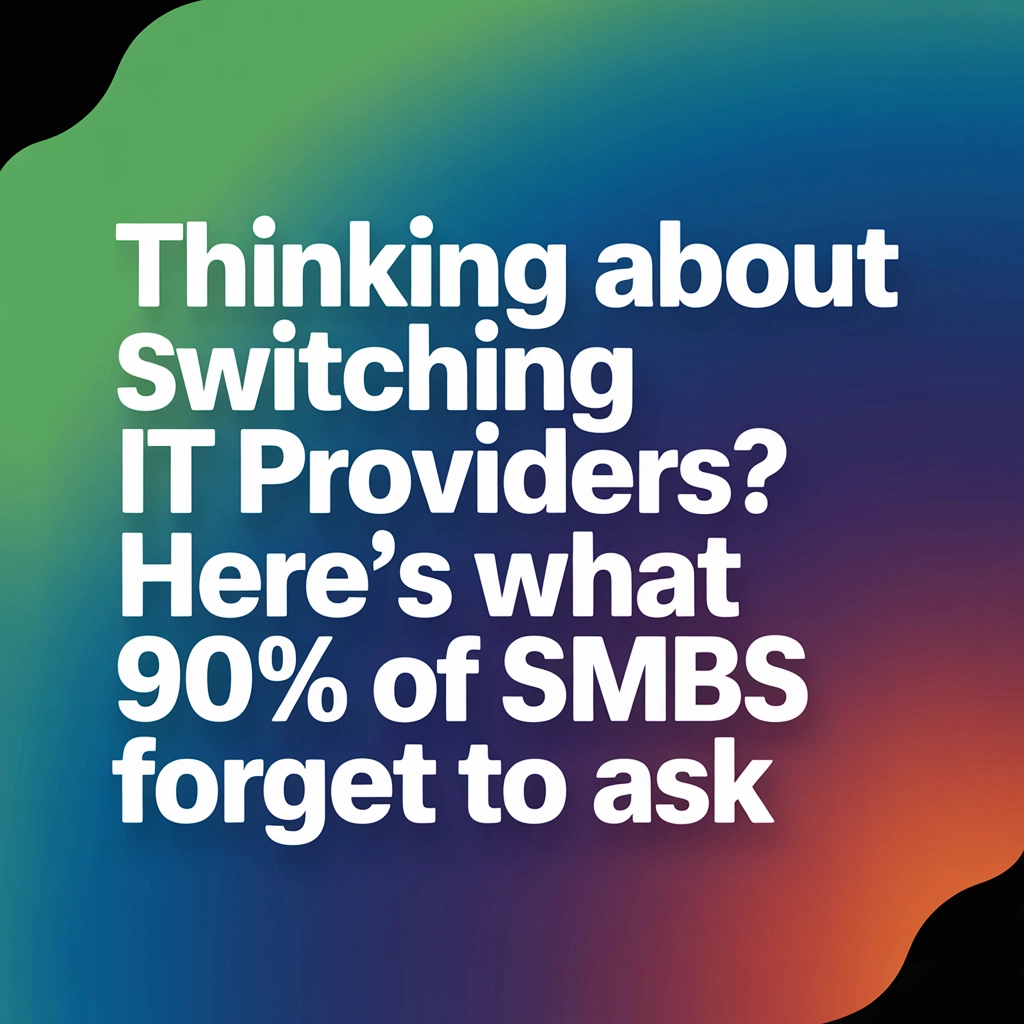
03 Sep Thinking About Switching IT Providers? Here's What 90% of SMBs Forget to Ask
You've finally had enough. Your current IT provider takes forever to respond, your systems keep going down at the worst possible times, and you're pretty sure you're paying too much for what feels like basic service. Sound familiar?
If you're nodding along, you're not alone. Research shows that 25% of businesses cite unacceptably high levels of technical downtime as their primary reason for switching providers. But here's the thing: while most SMBs nail the obvious questions like "How much will this cost?" and "What services do you offer?", they completely miss the make-or-break details that determine whether their switch will be a success story or a nightmare.
Let's dive into the critical questions that most businesses forget to ask: and why skipping them could cost you big time.
The Contract Trap: What's Really in Those Terms?

Most business owners treat contract reviews like reading terms and conditions: they scroll to the bottom and sign. Big mistake. Your current contract might have clauses that could derail your switching timeline or hit you with unexpected penalties.
The 90-Day Rule Everyone Misses
Here's something most providers won't volunteer: many IT service contracts require 90 days' notice before termination. Skip this step, and you might find yourself paying two providers simultaneously while dealing with a rushed, messy transition.
Start by asking your current provider about notice requirements: today, not when you're ready to make the switch. Then, when evaluating new providers, dig into their contract terms with questions like:
- What's the minimum contract length, and what are the penalties for early termination?
- Are there automatic renewal clauses that could lock you in longer than expected?
- What happens if your business needs change significantly during the contract period?
The Lock-in Agreement Loophole
Look for providers offering flexible arrangements with minimal lock-in requirements. The best IT partners understand that business needs evolve, and they're confident enough in their service quality to offer escape routes if things don't work out.
SLAs: The Devil's in the Details
Service Level Agreements sound impressive on paper, but they're only as good as their specifics. Most SMBs accept vague promises like "fast response times" without understanding what that actually means when their email server crashes at 3 PM on a Tuesday.
Response Time Reality Check
When evaluating providers, don't just ask about response times: ask about resolution times. There's a huge difference between "We'll acknowledge your ticket within 4 hours" and "We'll have your system back online within 4 hours."
Questions that separate the pros from the pretenders:
- What's your guaranteed response time for critical issues versus non-urgent requests?
- How do you define "critical" versus "non-urgent"?
- What penalties do you face if you don't meet these SLAs?
- Can you provide examples of actual response and resolution times from the past quarter?
After-Hours Support: When You Really Need It

Here's a scenario: It's Saturday morning, and your point-of-sale system goes down right before your busiest day of the week. You call your IT provider and get… voicemail.
Many IT providers offer "24/7 support" that's really just an answering service that takes messages. Ask specifically:
- Who responds to after-hours emergencies: your dedicated team or a third-party service?
- What's the escalation process for urgent issues outside business hours?
- Are there additional charges for emergency support?
The Documentation Disaster Most SMBs Walk Into
Imagine hiring a new mechanic who has no idea what work was done on your car previously. That's essentially what happens when you switch IT providers without proper documentation transfer.
Your Technology Inventory
Your new provider needs to understand every piece of technology they'll be managing. This isn't just about knowing you have 20 computers: it's about understanding your network configuration, software licenses, security protocols, and access credentials.
Critical documentation questions:
- What information do you need about our current setup to provide seamless service?
- How will you conduct the initial assessment and documentation of our systems?
- What happens if our current provider doesn't cooperate with information sharing?
Industry Expertise: One Size Doesn't Fit All

Here's a sobering statistic: 60% of SMEs reported cyber-attacks in the past year. If you're in healthcare, finance, or another regulated industry, generic IT support isn't enough: you need providers who understand your specific compliance requirements and threat landscape.
Compliance and Security Specialization
Don't assume all IT providers understand your industry's unique challenges. Ask pointed questions about their experience:
- How many clients do you support in our industry?
- What compliance standards are you familiar with that apply to our business?
- Can you provide references from similar businesses?
- How do you stay current with industry-specific regulations and threats?
Data Backup: Your Business's Lifeline
Every business owner says backup is important, but most have no idea how their current backup system actually works: or whether it would save them in a real disaster.
The 3-2-1 Rule Test
Ask potential providers about their backup strategy and see if they mention the 3-2-1 rule (3 copies of critical data, stored in 2 different types of media, with 1 copy stored offsite). If they don't bring this up, that's a red flag.
Essential backup questions:
- Where are our backups stored, and how often are they created?
- How do you test backup integrity to ensure data can actually be restored?
- What's your typical recovery time for different types of data loss scenarios?
- Can you walk us through exactly what would happen if we suffered a ransomware attack?
Future-Proofing: Planning for Growth

Most SMBs evaluate IT providers based on their current needs, completely forgetting to consider how their technology requirements might evolve. This short-sighted approach often leads to outgrowing providers within a year or two.
Scalability Questions That Matter
- How do you handle clients who need to rapidly scale up or down?
- What's your process for adding new locations or remote workers?
- How do contract terms adjust as our technology needs change?
- Can you share examples of how you've helped similar businesses grow?
Making the Switch: Transition Planning
The actual switching process can make or break your experience with a new provider. Many businesses focus so much on selecting the right provider that they give little thought to the transition itself.
Transition Timeline Reality
A proper IT provider transition typically takes 30-60 days when done right. Anyone promising to switch you over in a week is either cutting corners or doesn't understand the complexity of your systems.
Key transition questions:
- What's your typical timeline for transitioning a business our size?
- How do you minimize downtime during the transition?
- What role will our current provider play in the handoff?
- What should we expect in terms of temporary disruptions?
The Bottom Line
Switching IT providers is like changing doctors: it's not just about finding someone cheaper or more convenient. You need a partner who understands your business, can grow with you, and will be there when things go wrong.
The questions most SMBs forget to ask aren't just nice-to-haves: they're the difference between a smooth transition that improves your business operations and a disaster that costs you time, money, and countless headaches.
Before you sign on the dotted line with your next IT provider, make sure you've gotten satisfactory answers to all these questions. Your future self will thank you when your systems are running smoothly and your new provider is proactively solving problems before they impact your business.
Ready to ask the right questions? At Katalyst IT, we believe in transparency from day one. We're happy to answer every question on this list: and any others you might have. Because the best IT partnerships start with honest conversations about what you really need.




No Comments